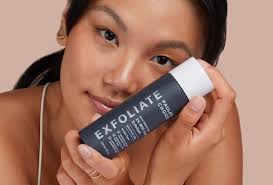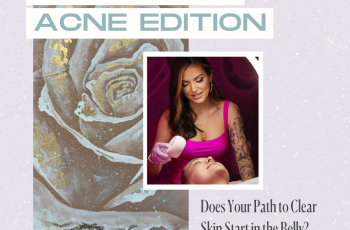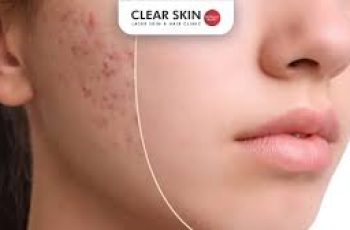How Does a BHA Exfoliant Work?
Exfoliating facial acids have truly established themselves in almost everyone’s skincare routine. From cleansers, toners and leave-on products there is sure to be a product that will work in your regime and deliver a variety of skin benefits.
This leads us to today’s post and answering a few of your questions about BHA exfoliants and how they actually work. Beta hydroxy acid (BHA), also known as salicylic acid, is a potent facial acid that unlike, AHAs, is oil-soluble meaning it is able to work further down the layers of the skin making it able to unclog pores of any bacteria, dirt or excess sebum which in time leads to blemishes, blackheads and other forms of breakouts. It is also able to buff away any build-up of dead skin cells which can give the skin a dull, flaky and lack lustre appearance.
Don’t forget you can find out more about beta hydroxy acids over on our website.
How do you use a BHA exfoliant?
To use a BHA exfoliant really boils down to which product it is you are using that contains the acid in the formula. As previously mentioned, there are a selection of products to choose from.
Face Cleanser or Wash
Requires water and rinsing
Ideal for using in the mornings to help brighten the skin for the day ahead
Always follow with an SPF at the end of your routine to protect from any sun exposure
Can be used in the evening too which will allow the product to work at clearing away any build of bacteria, dirt and traces of product
Cleansers/washes are better for a skin type that experiences some dryness as the product is rinsed off the face treats the skin for a shorter amount of time
Exfoliating Toner
Used on a cotton disc and applied onto the skin
Generally a lot more potent than cleansers and can help the BHA penetrate further into the skin clearing clogged pores and bacteria build-up
Helps to slough away dead skin cell build-up that can make the skin appear dull
Can be used morning and evening if skin doesn’t show signs of sensitivity
Serum or Face Oil
Applied after cleansing the skin and before moisturiser
Can be used AM and PM
Serums and oils stay on the skin for a longer amount of time and will show results a lot quicker
This product is best used for those who suffer from an oilier skin type and frequent breakouts
When adding BHA into your skincare routine you must first ensure your skin will benefit from it and not suffer from any reactions. It is best to consult a dermatologist if you find your skin to be prone to extreme dryness and sensitivity.
Can I use a BHA exfoliant every day?
This is dependent on your skin type and percentage of salicylic acid in the product formulation. For over the counter (OTC) products there is usually a lower percentage than products given by prescriptions, for those who have a dry and sensitive skin type it is best to use BHA exfoliant as specified by a dermatologist or skincare professional.
For the most part, using an BHA exfoliant every day in your routine should result in a number of skin benefits, especially if you have an oily or blemish-prone skin type. Just ensure you keep the balance of water and oil levels in your skin by using hydrating and moisturising products which contain hyaluronic acid and niacinamide within your regime. If at any point you find your skin starts to feel tight, uncomfortable and dry than reduce the amount of times you apply BHA exfoliants allowing your skin to restore balance to the outer layer and protective skin barrier.
How long does it take to work?
You will find there are some instant results when using a product containing salicylic acid, particularly chemical toners. The skin will appear fresher looking with a healthy glow, in regards to treating any breakouts or other blemishes, you can expect to see results in 4-6 weeks. This is from the continuous usage of salicylic acid, especially if it is blended into a face serum that is applied in the evening. This will not only give the BHA longer time on the skin, but will also be able to work undisturbed from any contact with any free radicals and other skin damaging compounds such as, UV exposure and pollution.
Does BHA dry out skin?
BHA is highly potent and when formulated to active levels in a product becomes a powerhouse ingredient. This makes it highly effective at giving results to the skin, but can become very drying to the skin.
How to avoid BHA drying out the skin;
Ensure it is safe to use BHA on your skin type, if you have concerns consult a dermatologist
If you experience any tightness or dryness to the skin when using BHA reduce the amount of times you use that product allowing the skin to restore balance
Do not overuse a product containing BHA, let the percentage in the formula do the hard work, do not use extra amounts for quicker results. This will only lead to the skin become drier and suffer from more severe breakouts
Always use highly hydrating ingredients in your serums and moisturisers, this will allow the skin to remain comfortable and skin protective barrier working correctly
What should you do after using BHA?
After using BHA there are a couple of steps you need to take to allow the skin ingredient to have a beneficial effect. This also depends on which product contains the acid in it also as the following steps can alternate.
Face cleanser or wash- Follow this step with a good skincare routine containing hyaluronic acid or niacinamide to give the skin a hydration boost and protecting the outer layers of the skin.
Exfoliating toners- After applying a hydrating serum or moisturiser, ensure you have protected the skin from UV exposure with a SPF of 30 and above.
Serum or oil- Keeping the skin protected from sun exposure is vital, especially whilst using a serum or oil as the BHA will work on the skin continuously. Apply a layer of SPF during the day and ensure you cleanse the skin fully of an evening to avoid any product build-up.
There you have some answers to how does a BHA exfoliant work. You will find that once your skin has gained a good tolerance to this potent skin ingredient your complexion will look better than ever!
DQH Knowledge drop: In your 20s, your skin cell turnover decreases. (Cell turnover is a key component in keeping your skin youthful.) You know what else slows down? Your collagen production. Starting in your 20s, collagen decreases by about 1 percent per year. Should you want to prevent fine lines and wrinkles, start by eliminating behaviors that contribute to premature aging. “If it’s bad for you, it’s bad for your skin,” says dermatologist Michel Somenek.
“Cigarette smoking reduces blood flow to the skin and causes premature wrinkling and a dull skin texture. Making the repeated pursed motion to inhale can also cause smoker’s lines. Alcohol and recreational drugs are toxins for the skin that damage its cellular structure and DNA,” Somenek tells us. “The faster you eliminate vices while you are young, the better chance your skin and body have to recuperate.” Also, adopting an anti-aging routine in your 20s is key. After all, the best offense is a good defense. We spoke to Somenek and experts Joshua Ross and Audrey Kunin to find out more.
Keep reading for the best anti-aging products for your 20s, according to skincare professionals.
Sunscreen
“We all know that the sun is the number one cause of skin aging and starting the prevention in your 20s is very important,” Ross says. “The majority of your sun damage won’t start to appear until you’re in your 30s, so don’t wait until you see it surface or you’ll be behind the curve. Stay ahead of it with a good-quality zinc-based sunscreen worn daily.”
Farmacy Green Defense Daily Mineral Sunscreen
An invisible sunscreen with SPF 30, plus botanical extracts meant to protect skin with tons of antioxidants. Bonus: It’s clean and fine to use under makeup.
Bareminerals Complexion Rescue™ Tinted Moisturizer Broad Spectrum SPF 30
Although we recommend you use your SPF and moisturizer separately, we also understand moments when you don’t have time or energy for that extra step. For those times, this bareMinerals moisturizer is a great thing to have on hand.
Vitamin C Serum
“A great introduction to anti-aging is to start with a vitamin C serum in your morning skincare routine,” Ross says. “It’s a powerful antioxidant that will neutralize free radicals and brighten the skin.” He adds that it’s a great way to counteract the effects of the sun’s harmful rays, which, as previously mentioned, are among the biggest causes of premature aging.
Drunk Elephant C-Firma™ Vitamin C Day Serum
The Drunk Elephant C-Firma is a lightweight serum that promises to give skin a glow by combining the brightening powers of vitamin C with ferulic acid, l-ascorbic acid, and vitamin E. The included sodium hyaluronate is meant to replace hydration loss, so you shouldn’t have to deal with any irritation.
Sunday Riley C.E.O. Rapid Flash Brightening Serum
This potent serum is jam-packed with vitamin C (15 percent, to be exact), which means it’s a potential superstar at both brightening skin and dousing it in antioxidants.
Peptides
Using peptides on your skin has many benefits, says Somenek. “The skin barrier is what defends the body against pollution, UV rays, bacteria, and toxins. It can be damaged by several everyday factors. Using topical peptides aids in building a stronger barrier,” he says. “Peptides comprise elastic fibers, which are a type of protein. These fibers help to make skin appear taut and firm. Peptides can also help repair damaged skin, relieve inflammation, and even out skin tone. Some peptides can kill acne-causing bacteria that is common in 20-somethings.”
Kunin agrees, saying, “Peptides are an excellent entry point for supporting collagen.” She recommends looking for face and eye treatments that contain these collagen-boosting powerhouses.
Charlotte Tilbury Magic Eye Rescue Cream
This Charlotte Tilbury super-emollient eye cream has a base of coconut oil and shea butter (read: it’s incredibly hydrating). Botanicals plus peptides are meant to help reduce dark circles and boost collagen, respectively.
This creamy moisturizer serves up potent collagen-boosting peptides and pycnogenol, and antioxidant-rich vitamin C. “Instead of sitting on top of the skin, peptides penetrate the outer layer so they go deep. The ‘signals’ they send tell the cells to produce elastin and collagen, which are needed for youthful-looking skin,” explains Somenek.
At-Home Peel Pads
Remember that skin cell turnover fiasco we talked about earlier? One way to help support it is by exfoliating. “Exfoliation is important to help keep skin fresh and luminous,” Kunin says. She recommends using at-home peel pads as an easy and effective way to exfoliate.
“The goal in your 20s is to fight the slowing pace of cell turnover. It is wise to use products that gently exfoliate, yet still remove oil and other impurities. Products that have Alpha Hydroxy Acids (AHA) or Beta Hydroxy Acids (BHA) are a good choice.”
According to Somenek, you should only exfoliate two to three times a week. “People of all ages are guilty of over-exfoliating and that can be too much of a good thing,” he says.
Dermadoctor Kakadu C Intensive Vitamin C Peel Pad
A few swipes of this Derma Doctor powerful peel pad promise to leave your skin glowing and smooth, thanks to the seven (yes, seven) types of chemical exfoliants, including AHA and BHA. It also contains vitamin C via Kakadu plum extract for added brightening and antioxidant protection.
KEY INGREDIENTS Kakadu plum extract is sourced from the Kakadu plum, a fruit grown in northern Australia. It contains vitamin C, which restores the skin’s natural barrier, increases collagen production, and soothes irritation.
Dr. Dennis Gross Skincare Alpha Beta® Universal Daily Peel Pads
These are the gold standard of peel pads, with a cult following and over 900 five-star reviews on Sephora. They’re easy to use and contain a blend of anti-aging exfoliating acids.
Emollient Night Cream
“In your 20s, you need to start upping the hydration in your skincare routine. You may have been cautious of over-moisturizing because of acne in your teens, but as you enter your 20s, your skin transitions and becomes drier,” Ross says. “I recommend an emollient night cream added into your evening skincare regimen.”
“Twenty-somethings need to make sure that they are not using creams that will clog their pores and cause excess oil production,” says Somenek. Opt for non-comedogenic products.
Cerave Skin Renewing Night Cream
One great choice is the CeraVe Skin Renewing Night Cream, which is a non-comedogenic night cream that leaves skin soft and glowy. It combines the moisturizing powers of ceramides and hyaluronic acid.
RoC Retinol Correxion Max Hydration Creme
“The best night cream ingredients contain retinol, benzoyl peroxide, and/or salicylic acid or hyaluronic acid. The goal is to moisturize, yet remove excess oil,” says Somenek. This Roc Retinol Correxion cream fits the bill as it contains both hyaluronic acid and retinol so it promises to moisturize while also being non-comedogenic.



